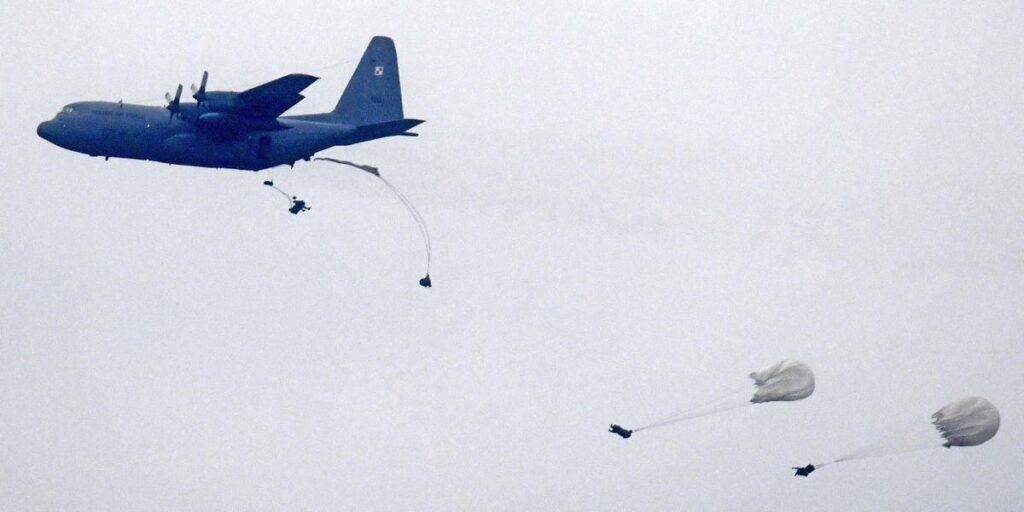PYHTÄÄ, Finland — The young soldiers wear dark camouflage and green and black face paint to blend in with the dense forest common on NATO’s eastern flank.
These conscripts, members of the 3rd Jaeger Company, a unit within the Finnish Army’s Pori Brigade, carry anti-tank missile launchers, large mines, and assault rifles. One soldier looks at a paper map, and another calls in instructions on the radio as they scout out recently seized enemy positions. From the nearby road, they cannot be seen.
The Finnish soldiers are conducting surveillance operations, but the enemy is not real. It’s part of an exercise simulating their reaction to the capture of a strategic airfield, a critical operation that’s an expected element of a Russian invasion.
Lively Sabre 25, which took place in southern Finland over the past few days, is an element of NATO’s larger Swift Response 25 exercise. This event is a series of joint military drills across the Baltic and Nordic regions designed to facilitate cooperation among allies and deter what they see as a serious Russian threat to the east.
During Lively Sabre, a “red team,” consisting of Polish airborne forces and Finnish troops, executed a tactical air landing operation at an airstrip in the forest. Paratroopers rapidly seized a strategically located airfield, aiming to hold it and bring in the infantry and heavy weapons to launch a lightning assault from it; Russia used similar tactics in a close battle outside Kyiv in 2022.
The 3rd Jaeger Company was part of a “blue team” made up entirely of Finnish troops whose mission was to contain the so-called airhead and then mass strength to retake the site — an operation where time is of the essence.
Jake Epstein/Business Insider
Finland doesn’t have an airbone brigade in its military structure, so the exercise is a good opportunity to train on battling paratroopers and learn from skilled professionals — in this case, the Polish forces — how to prepare for a tactical air landing, set up a perimeter around the airfield, and defend the site. Establishing an airhead is not an easy operation, especially in an era of widespread sensors and sophisticated air defenses that can detect and destroy an assault force before it lands.
“It’s extremely difficult,” Col. Matti Honko, the commanding officer of Finland’s Guard Jaeger Regiment and the director of Lively Sabre, told Business Insider on the sidelines of the exercise. “There needs to be suppression of the air defense, and there has to be air superiority. You have to be able to actually do lots of things before you can do that.”
Brig. Gen. Michal Strzelecki, the commander of Poland’s 6th Airborne Brigade, which led the tactical air landing, said these operations have become even more difficult now than they were in past years. But having the airborne capabilities is still crucial, especially in the early phases of a conflict, when enemy air defenses aren’t necessarily ready. The rapid deployment of troops could make all the difference.
“Having that kind of capability is essential,” Strzelecki told BI at the Pyhtää airfield.
The ability to seize an airstrip and hold the position is important, as is the ability to dislodge it from under enemy control. NATO knows this because Ukraine demonstrated it three years ago, early on in its defense against Russia’s full-scale invasion.
Jake Epstein/Business Insider
Russian forces tried to capture the Hostomel airport on the outskirts of Kyiv amid their initial push to capture the Ukrainian capital city. This would have given Moscow a decisive advantage, as the Kremlin could have then airlifted more troops, artillery, and fighting vehicles to strike Kyiv from a minimal distance.
Russian helicopters carrying assault troops made an initial assault, but they were met with fierce resistance from Ukraine’s military. After hours of heavy fighting and counterattacks, Kyiv eventually controlled the airfield.
Swift Response 25, which falls under NATO’s larger series of exercises this summer, called Defender, comes as the military alliance grows increasingly concerned with Russia and its behavior across Europe, which Western officials have described as malign and aggressive.
Allies, especially those along the northern and eastern flanks, like the Baltic states, are watching the Ukraine war closely. They are investing a lot in their defense capabilities by increasing their military spending, buying up weapons, and reinforcing their borders. European nations are also anxious about US reliability.
Finland joined NATO just over two years ago, while Poland has been a member for more than two decades. Both share borders with Russia, so they bring an important perspective to the alliance as countries on its front lines. They are well aware of the Russian threat.
Photo by Celestino Arce/NurPhoto via Getty Images
Strzelecki said the Lively Sabre exercise helps Poland better integrate its forces with Finland.
“Finland is a new member of the alliance, so we want to interact with them, we want to train with them, we want to share our experience and also learn from the Finnish Army,” he said. “Finland has a long tradition of defending against possible aggression from their neighbor.”
Indeed, Russia has recently increased its military presence along its shared 830-mile-long border with Finland. Should a clash occur between NATO and Moscow, the region could become a major hot spot.
Honko said Finland’s accession to NATO in 2023 has already lifted the threshold of threats, and exercises like Lively Sabre are a key element of deterrence that’s needed to avoid a real shooting war.
“We are in the first line, but then, I think we have a very long tradition of defending our own area by ourselves, and that hasn’t changed. In a way, we are a security provider, and not a security consumer,” Honko said. Still, he added, “We need the alliance if the day comes, and we can deal with the problem together.”



